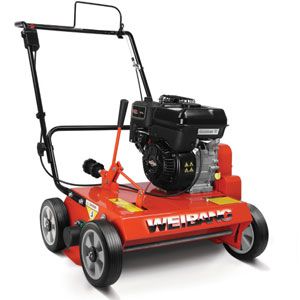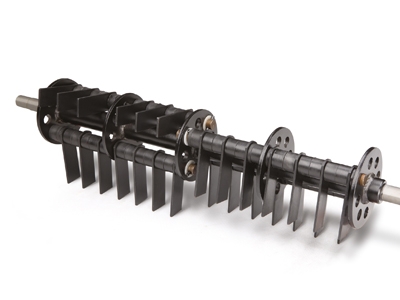
The Weibang WB486CRB is controlled by a clutch system, the scarifying rotor is fitted with 28 double tipped carbonsteel blades. Raking depth is fully adjustable to a maximum 7cm, to remove moss and thatch
The Weibang WB 486CRB is controlled by a clutch system, the scarifying rotor is fitted with 28 double tipped carbonsteel blades. Raking depth is fully adjustable to a maximum 7cm, to remove moss and thatch and aerate roots gently but effectively. Powered by an easy to start, reliable 5hpBriggs & Stratton engine, the WB486CRB scarifier has a max 46cm working width.The pressed steel body has a hard wearing powder-coated finish and is extremely durable, ensuring your product lasts.
Swing Blade Design
The blades fitted to the Weibang Intrepid range of petrol scarifiers are swing tip and made of carbon steel. This offers minimal maintenance even when a hard object is struck.
| Service Code | WB486CRB |
|---|---|
| Engine | Briggs & Stratton 750 Series |
| Power (kW) | 3.3kW @ 3300rpm |
| Displacement (cc) | 163cc |
| Fuel Tank Capacity | 3.1 Litres |
| Chassis | Steel |
| Working Width | 46cm / 18" |
| Work Area | up to 3000m² |
| Blade type | 28 Swing Tip Blade |
| Blade Material | Carbon Steel |
| Wheel Drive | N/A |
| Collector capacity | N/A |
| Folding Handles | Yes |
| Handle height adjustment | No |
| Handle Bar Controls | Stop Switch & Blade Engagement |
| Working Height | 32mm of Adjustment |
| Cutting Height Adjustment | Central |
| Maximum Ground Penetration | 16mm |
| Wheel Diameter | 198mm |
| Wheel Type | Nylon |
| Ball Bearing Wheels | Double |
| Vibration Level (m/s2) | 5.4m/s² |
| Weight (kg) | 58.3kg |
| Warranty Commercial | 1 Year |
| Warranty Domestic | 5 Years (T&C's apply) |
What is Scarifying?
Scarifying is the process where the soil beneath the lawn is scraped and the thatch and moss are removed from the surface of the lawn. By doing this, you are enabling the soil to absorb more essential nutrients which promotes lawn growth. This can be done manually with a lawn rake but this can be a time consuming and energy sapping task. Using a petrol scarifier enables you to achieve better results with minimal effort.
What is thatch?
Thatch is a layer of dead grass and roots which builds up above the soil in the lawn. This layer can prevent water, oxygen and nutrients penetrating the ground and reaching the grass root.
When is it best to scarify the lawn?
The best times to scarify the lawn are in Spring and Autumn. Plan to carry out your first scarifying of the season in the Spring between April and May when the ground temperature has reached 8c and there is little risk of frost. By scarifying in Spring you are allowing enough time for the grass to recover prior to the drier summer months. If scarifying in very dry conditions you should ensure it is thoroughly watered once completed. Additionally, scarifying in Autumn is recommended to remove any thatch which has developed over the summer but make sure the lawn has enough recovery time before the ground gets too cold.
If my lawn has a lot of moss and thatch, should I scarify the lawn more vigorously in Spring or Autumn ?
One thing to consider is that when you scarify the lawn in Spring, you are effectivley creating bare areas where not only new grass can grow, but also weeds. For this reason, if possible the more vigorous scarification should take place in the Autumn when weeds are less likely to develop.
Should I mow the lawn prior to scarifying?
When the ground temperature is approximately 8C the grass will start to grow again at which point the lawn should be cut at least once before scarifying. Remember to only cut 1/3 of the grass length in one go. A grass length of 4cm is ideal for scarifying.
Can you scarify in wet conditions?
It is recommended that the surface of the lawn Is dry but there is moisture in the ground when you scarify the lawn. If the surface of the lawn is wet the scarifying process will not be as effective.
Can you scarify a recently laid lawn.
When scarifying, any grass which does not have sufficiently developed root structures will be removed, so lawns younger than three years old are not suitable for scarifying.
How low should the scarifier blades be whilst scarifying the lawn?
This depends on the amount of thatch. The scarifier blade should be just touching the soil below the lawn.
What is the difference between scarifying and aeration?
Scarifying is a less invasive process as there is minimal penetration of the ground whereas an aerator machine produces holes in the lawn. Aeration is particularly beneficial in areas of high soil compaction which can lead to poor drainage as well as an unhealthy lawn as nutrients will just sit on top of the ground rather than making their way down to the grass roots. A Weibang lawn aerator penetrates the soil with a hollow tine and removes a ‘plug’ of soil.
Can I over-seed the lawn after scarifying the lawn?
Sowing additional grass seed on the lawn after scarifying is highly recommended. By re-seeding areas which have become bare during the scarifying process not only will your lawn look thicker and more attractive, it helps to prevent weeds and moss growing in those areas. As well as over-seeding the lawn, adding a lawn fertiliser will aid the recovery of the lawn to ensure the lawn has the required nutrients to grow.
Can I use the WB384RB petrol scarifier without the collector?
Yes, the collector does not need to be fitted if you would rather complete the scarifying work and then collect the debris afterwards. The collector is useful when working in small gardens as there is no need to clear up afterwards.
Delivery where offered is usually 1 – 7 working days for most smaller products in the UK mainland.
We do NOT deliver to the Scottish Islands or the Isle of Wight.
We do NOT supply all machines nationally;
Our priority is to fulfil deliveries local to our business.
Garden Tractors are normally delivered within 7 – 10 working days due to the need to build, PDI and test them prior to delivery to ensure they reach you ready to cut grass.
Unfortunately, we cannot guarantee next day delivery on any product.
If your order is time sensitive, please call us for a delivery date.
If click and collect is chosen, please wait for us to notify you that your order is ready to collect.